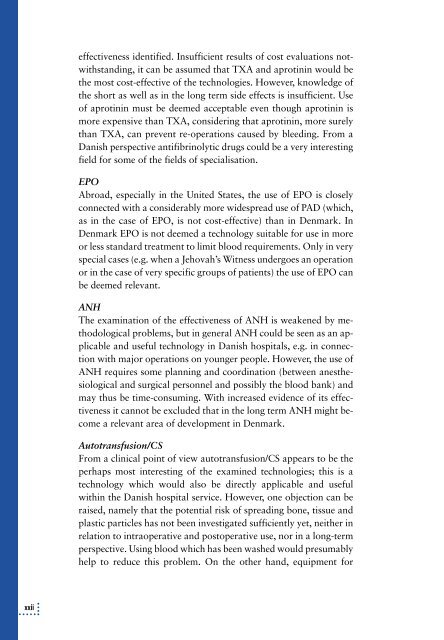Elektronisk udgave - Sundhedsstyrelsen
Elektronisk udgave - Sundhedsstyrelsen
Elektronisk udgave - Sundhedsstyrelsen
Create successful ePaper yourself
Turn your PDF publications into a flip-book with our unique Google optimized e-Paper software.
xxii<br />
effectiveness identified. Insufficient results of cost evaluations notwithstanding,<br />
it can be assumed that TXA and aprotinin would be<br />
the most cost-effective of the technologies. However, knowledge of<br />
the short as well as in the long term side effects is insufficient. Use<br />
of aprotinin must be deemed acceptable even though aprotinin is<br />
more expensive than TXA, considering that aprotinin, more surely<br />
than TXA, can prevent re-operations caused by bleeding. From a<br />
Danish perspective antifibrinolytic drugs could be a very interesting<br />
field for some of the fields of specialisation.<br />
EPO<br />
Abroad, especially in the United States, the use of EPO is closely<br />
connected with a considerably more widespread use of PAD (which,<br />
as in the case of EPO, is not cost-effective) than in Denmark. In<br />
Denmark EPO is not deemed a technology suitable for use in more<br />
or less standard treatment to limit blood requirements. Only in very<br />
special cases (e.g. when a Jehovah’s Witness undergoes an operation<br />
or in the case of very specific groups of patients) the use of EPO can<br />
be deemed relevant.<br />
ANH<br />
The examination of the effectiveness of ANH is weakened by methodological<br />
problems, but in general ANH could be seen as an applicable<br />
and useful technology in Danish hospitals, e.g. in connection<br />
with major operations on younger people. However, the use of<br />
ANH requires some planning and coordination (between anesthesiological<br />
and surgical personnel and possibly the blood bank) and<br />
may thus be time-consuming. With increased evidence of its effectiveness<br />
it cannot be excluded that in the long term ANH might become<br />
a relevant area of development in Denmark.<br />
Autotransfusion/CS<br />
From a clinical point of view autotransfusion/CS appears to be the<br />
perhaps most interesting of the examined technologies; this is a<br />
technology which would also be directly applicable and useful<br />
within the Danish hospital service. However, one objection can be<br />
raised, namely that the potential risk of spreading bone, tissue and<br />
plastic particles has not been investigated sufficiently yet, neither in<br />
relation to intraoperative and postoperative use, nor in a long-term<br />
perspective. Using blood which has been washed would presumably<br />
help to reduce this problem. On the other hand, equipment for

















